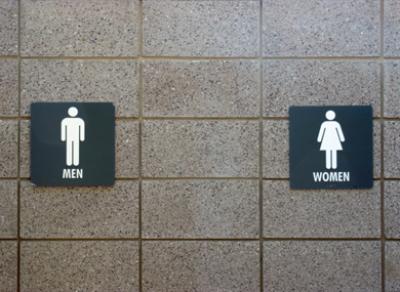
By Morgan Hays
Late March and early April 2015 have brought mass media attention to the Lesbian-Gay-Bisexual-Transgender-Questioning (L.G.B.T.Q.) community. The first media sensation involved the highly controversial Indiana Religious Freedom Restoration Act and the series of amendments shortly thereafter. [1] The second instance involved a decision made much closer to home (at least geographically). Last week, Federal Judge Kim R. Gibson dismissed former Pitt student Seamus Johnson’s 2012 lawsuit against the University of Pittsburgh. [2] When Seamus applied to the University of Pittsburgh (Pitt) in 2009, he listed his gender as the one assigned to him at birth: female. Seamus began therapy and hormone treatments to transition to the male gender during his time attending Pitt’s Johnstown campus from 2009-2011. [3]
After beginning his transition to male, Johnson provided Pitt with documentation of his new legal name and notified administration of the changes he was undergoing. In the meantime, he used men’s bathrooms and men’s locker rooms on campus. [4] After enrolling in a men’s weight training course, however, the university began asking Seamus to stop using the men’s restrooms and locker rooms and insisted he use a unisex locker room typically reserved for use by referees. [5] Seamus refused, continued to use the male facilities, and was eventually charged with “’exhibiting disorderly, lewd or indecent behavior,’ and disregarding directives from the university.” [6] Seamus brought suit against the university, alleging sex discrimination under Title IX and a violation of the equal protection clause of the Constitution. [7]
In dismissing the suit, Judge Gibson found Title IX “‘does not prohibit discrimination on the basis of gender identity,’” and that transgender status does not constitute a “‘suspect class’” for purposes of equal protection. [8] Thus, Pitt is only required to provide a “‘rational basis’” for requiring Seamus to use a unisex facility as opposed to a male one. Other courts have found Title IX does prohibit discrimination on “sex-based stereotypes.” [9] Consequently, California, Colorado, Connecticut, and Massachusetts have “statewide trans-inclusive regulatory policies” and antidiscrimination statutes in place, allowing students to choose restroom use based on their interpretation of their gender. [10] Two landmark cases have also been decided in the last few years, paving the way for equality for transgender students at all levels of schooling. The first case, decided in Colorado, involved a six-year-old transgender girl who was allowed to use female restrooms in kindergarten, but upon reaching first grade was forbidden from doing so. [11] The decision in the case, written by Steven Chavez, director of the civil rights division, reasoned that discriminatory bathroom policies for transgender students foster “‘social disengagement’” and are reminiscent of “‘the reviled doctrine of separate but equal.’”[12] The Maine Human Rights Commission decided a similar case in favor of a transgender elementary student in 2014. [13]
While the Pennsylvania decision represents a set-back in the crusade for transgender equality, Seamus Johnson’s struggle did not go unnoticed to Judge Gibson. [14] Specifically, Judge Gibson commented that ‘“[t]he court notes . . . society’s changing views of gender, gender identity, sex and sexual orientation have significantly evolved in recent years,”’ and that the ‘“legal landscape is transforming as it relates to gender identity.”’ [15] Pitt has also issued a statement in response to the decision, urging that it ‘“was never [their] intent to violate anyone’s rights.”’[16] Director of Colorado’s Civil Rights Division Steven Chavez continues to hold out hope that schools across the nation stay “interested in doing the right thing, and [continue] to look to courts and government agencies [like ones in Colorado] for guidance.” [17]
[1] Monica Davey, Campbell Robertson & Richard Pérez-Peña, Indiana and Arkansas Revise Rights Bills, Seeking to Remove Divisive Parts http://www.nytimes.com/2015/04/03/us/indiana-arkansas-religious-freedom-bill.html (accessed Apr. 3, 2015).
[2] Scott Jaschik, Transgender Setback https://www.insidehighered.com/news/2015/04/03/federal-judge-denies-claim-transgender-man-expelled-u-pittsburgh-over-restroom (accessed Apr. 3, 2016).
[3] Id.
[4] Id.
[5] Id.
[6] Id.
[7] Id.
[8] Id.
[9] See generally Snelling v. Fall Mt. Regl. Sch. Dist., CIV. 99-448-JD, 2001 WL 276975, at *4 (D.N.H. Mar. 21, 2001); Higgins v. New Balance Athletic Shoe, Inc., 194 F.3d 252 (1st Cir. 1999).
[10] Chapter Two: Transgender Youth and Access to Gendered Spaces in Education, 127 Harv. L. Rev. 1722, 1730 (2014).
[11] Id. at 1731.
[12] Id. at 1732.
[13] Id. at 1733.
[14] Scott Jaschik, Transgender Setback https://www.insidehighered.com/news/2015/04/03/federal-judge-denies-claim-transgender-man-expelled-u-pittsburgh-over-restroom (accessed Apr. 3, 2016).
[15] Id.
[16] Id.
[17] Transgender Youth and Access to Gendered Spaces in Education, 127 Harv. L. Rev. at 1732.